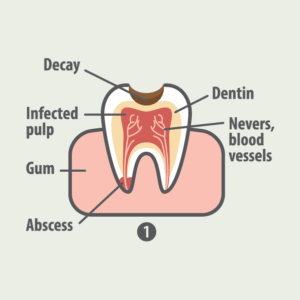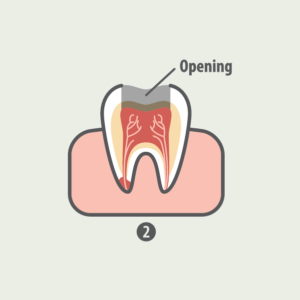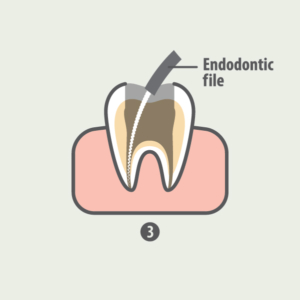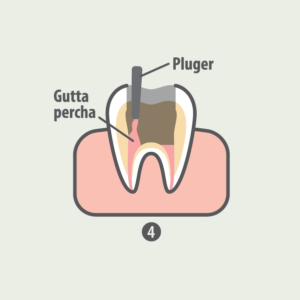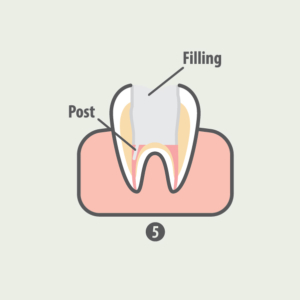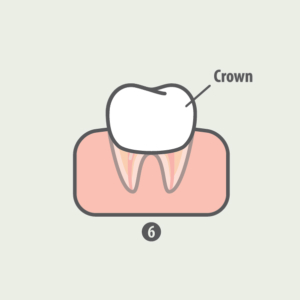Root Canal Treatment
 Root canal treatment, also known as endodontics (“endo” – inside, “dont” – tooth), is a series of procedures designed to treat problems of the soft pulp (nerve) tissue inside the tooth. Root canal is normally thought to be a very painful treatment, however this is not always the case. Normally it is no worse than getting a filling, and is one of the most effective ways of relieving some tooth pain.
Root canal treatment, also known as endodontics (“endo” – inside, “dont” – tooth), is a series of procedures designed to treat problems of the soft pulp (nerve) tissue inside the tooth. Root canal is normally thought to be a very painful treatment, however this is not always the case. Normally it is no worse than getting a filling, and is one of the most effective ways of relieving some tooth pain.
Pulp tissue consists of blood vessels, connective tissue, and nerve cells. If these become infected of inflamed, you may feel sharp pains. These pains may go away temporarily, but without a root canal treatment the infection won’t. This can lead to a dental abscess, which could potentially contribute to problems in other parts of the body.
Root Canal Treatment is Your Friend
We’ve all heard people say how a root canal is painful and undesirable. It always seems to be the thing people don’t want to have. However, the notion that a root canal invariably comes with complications and pain is a myth. What is true, is that infection and inflammation of pulp tissue is painful. Root canals eliminate this pain.
Need another reason to accept the benefits of root canals? It can save your teeth, which means avoiding problems related to tooth loss. These include unwanted tooth migration or shifting, which leads to difficulties in chewing; bridgework or dental implants, which can be costly and complicated; and the eventual loss of bone structure from the area of the missing tooth.
Causes of Root Canal Problems
Root canal problems come from infection and inflammation of a tooth’s pulp tissue. This is potentially caused by deep tooth decay. Cavities that are left untreated will allow bacteria to slowly work its way down to the center of the tooth, where the pulp tissue can get infected. Chipped or cracked teeth may also allow bacteria to crawl towards the pulp. Any opening in the protective enamel coating could potentially allow bacteria to infect the tooth pulp.
Trauma to the tooth – resulting from sports injuries to car accidents, for example – can also cause pulp tissue damage. If this is the cause, it is essential to seek treatment immediately to save toe tooth and prevent future problems.
At times, extensive dental work itself may cause damage to the pulp tissue and requires a root canal. If a tooth has had multiple filings or restorations, it is more likely to be susceptible to pulp infection or inflammation. Even common procedure like crown preparation or orthodontics could potentially lead to root canal problems. Thus, it is always important to maintain a routine dentist visit to check up on the status of your teeth.
What to Expect During Root Canal Therapy
If after an examination you need root canal therapy, don’t worry. It’s a common and effective treatment that can be taken care of in one visit.
The root canal process begins just like a regular filing does. An anesthetic is applied to the tooth and surrounding area to numb the feeling. This is usually the toughest part, and is smooth sailing from here.
A small opening is then made into the affected tooth. This gives the dentist access to the pulp chamber and root canals. Small, precise instruments are then used to remove the dean and infected pulp tissue. The opening and emptied canals are cleaned, disinfected, and prepared to be filled with inert, biocompatible material. To finish the process an adhesive cement is used to seal the opening in the tooth, which prevents future infection.
Sensitivity or tenderness of the tooth may be experienced after treatment. During this time, over-the-counter pain relievers such as ibuprofen are usually acceptable ways of relieving any discomfort, but prescription medications may also be given if the pain persists. While your tooth is healing is helps to eat soft foods and avoid chewing on that tooth. All of these symptoms should be temporary.
A crown or other restoration may be needed to further protect and restore your tooth. This could entail a traditional gold crown or tooth replicas made to match the natural appearance of your teeth. Whichever method you use, it will preserve your dental health for years.
What to Expect During Root Canal Therapy
If after an examination you need root canal therapy, don’t worry. It’s a common and effective treatment that can be taken care of in one visit.
The root canal process begins just like a regular filing does. An anesthetic is applied to the tooth and surrounding area to numb the feeling. This is usually the toughest part, and is smooth sailing from here.
A small opening is then made into the affected tooth. This gives the dentist access to the pulp chamber and root canals. Small, precise instruments are then used to remove the dean and infected pulp tissue. The opening and emptied canals are cleaned, disinfected, and prepared to be filled with inert, biocompatible material. To finish the process an adhesive cement is used to seal the opening in the tooth, which prevents future infection.
Sensitivity or tenderness of the tooth may be experienced after treatment. During this time, over-the-counter pain relievers such as ibuprofen are usually acceptable ways of relieving any discomfort, but prescription medications may also be given if the pain persists. While your tooth is healing is helps to eat soft foods and avoid chewing on that tooth. All of these symptoms should be temporary.
A crown or other restoration may be needed to further protect and restore your tooth. This could entail a traditional gold crown or tooth replicas made to match the natural appearance of your teeth. Whichever method you use, it will preserve your dental health for years.

